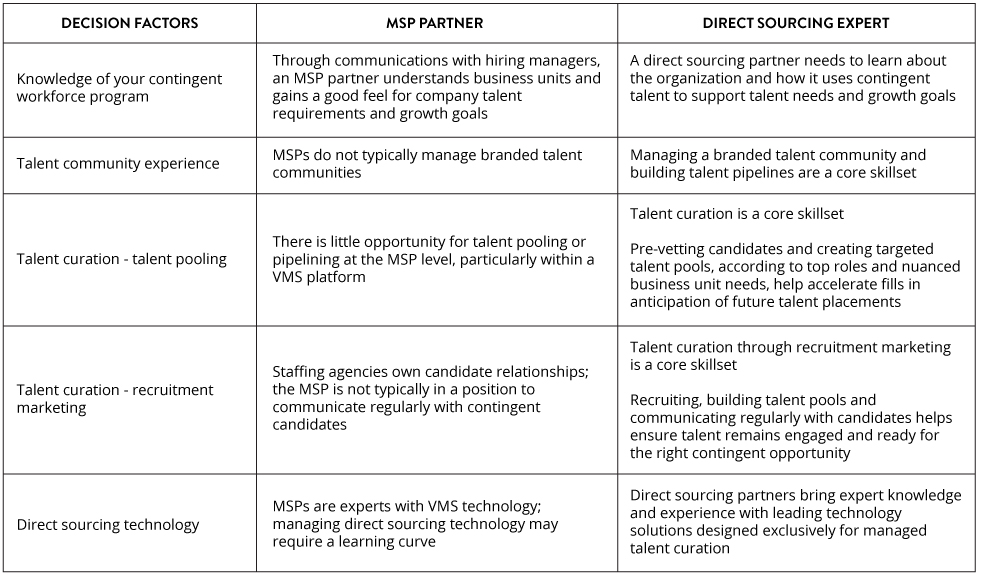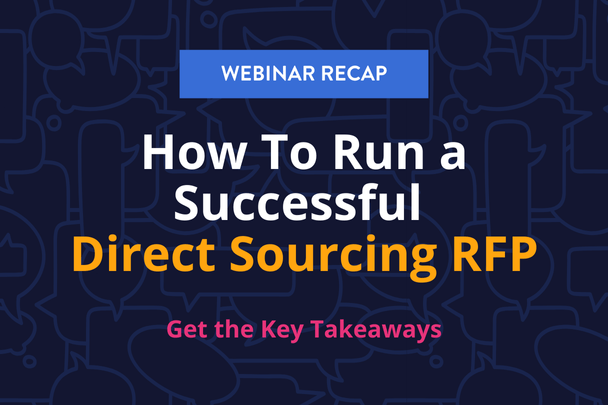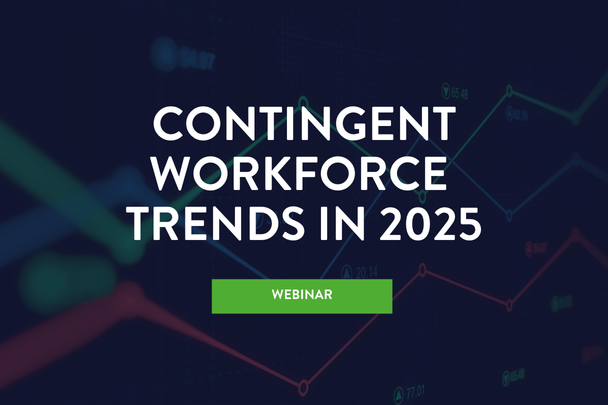Managed Talent Curation: Trust It to an MSP or a Direct Sourcing Expert?
Why are superstores so successful? They offer a little bit of everything to appeal to everyone at reasonable prices. And you can find one in nearly every town. There isn’t much a person couldn’t buy at a superstore, so how do specialist retailers survive? They would say it’s their deep expertise and a strong focus on customer service. They may offer fewer choices than a big box store, but they are all premium choices. Whether to shop the superstore or the specialist will depend on your needs and what is of most value to you. The same principles apply once you’ve made the decision to leverage the power of your own brand to attract contingent talent and introduce managed talent curation.
How will you manage your talent curation effort?
There are two obvious choices for managing talent curation. Turn direct sourcing over to a managed service provider (MSP) to be integrated into your existing contingent workforce program or look to a dedicated expert in direct sourcing to manage talent curation. To some extent, the decision will depend upon the size and maturity of your contingent workforce program. Other factors to be weighed in making a choice include what you want, what you need and which managed process can consistently deliver the best talent to support growth.
Is it more critical to have an innate understanding of the business and company culture or to bring proven experience in managed talent curation? A careful examination of the benefits and risks of adding direct sourcing to an existing contingent workforce program or taking advantage of a workforce solutions specialist in managing talent curation can clarify the best route forward for your organization.
How to succeed at direct sourcing and managed talent curation
Direct sourcing has the potential to transform a company’s ability to fill contingent roles by opening up a new sourcing channel that introduces contingent opportunities to a pre-engaged talent pool, populated with many people you already know. An established sense of connectedness can lead to higher-quality candidates for contingent roles, accelerated hiring decisions, easier onboarding and a shorter productivity ramp, all at a lower cost than traditional contingent talent sourcing.
To be successful in direct sourcing requires four key elements:
- A branded talent community, attracting people who know your company and those who are interested in getting to know you.
-
-
- This can include your former proven performers, such as interns, consultants, freelancers and other temp workers.
- You can also capture active and passive job seekers who are interested in your brand.
-
- Managed talent curation.
- Here resides an opportunity to develop talent pools that align with your current and future staffing needs, in terms of skills, experience, location, etc
- Recruitment marketing to attract and ensure candidates in the talent community remain engaged.
- Here resides an opportunity to develop talent pools that align with your current and future staffing needs, in terms of skills, experience, location, etc
- Direct sourcing technology to facilitate the process. Leading solutions include TalentNet, LiveHire, WorkLLama, and WillHire.
- Dedicated resources to manage the direct sourcing program, specifically an MSP or a direct sourcing partner.
Integrating direct sourcing into a contingent workforce program
When a contingent workforce program reaches the point where it is increasingly challenging to manage your staffing agencies, bill rates, timekeeping methods, contracts and all the invoices associated with filling contingent workforce positions, it’s time to partner with an MSP.
An MSP serves as the central clearinghouse for approved staffing vendors. It manages all approved suppliers, job requisitions, talent placements, bill rates, timekeeping, contracts and invoicing, while providing visibility into how an organization uses (and what it pays for) contingent talent.
And it does so at best practice and scale, making it easy to add new suppliers at any time, as well as identify continued opportunities for innovative talent strategies. The MSP program optimizes service and pricing and creates guidelines to source and slot new suppliers into the program, according to operating protocols.
When a direct sourcing program is integrated within an MSP program, the company acts like a “new supplier” of contingent talent. It’s best practice to consider lead time for the direct sourcing provider: whether operating as Tier Zero, allowing 24-72 hours before the role is released to other suppliers, or operating at Tier 1, in tandem with your priority suppliers.
With a direct sourcing program, the MSP will need to take on new responsibilities for managing direct sourcing that do not apply to all other program participants, especially managing a branded talent community and talent curation.
Managing direct sourcing is usually a matter of maturity
Smaller or mid-sized organizations that are exploring the power of direct sourcing may not have enough volume in new roles or high talent turnover to warrant an independently managed direct sourcing program. It might be best in these scenarios to tuck the direct sourcing program under the wing of the MSP. It may require additional recruitment personnel resources from the MSP, but in a smaller, less mature contingent workforce program, there should be enough flexibility to accommodate the one-off nature of the direct sourcing program.
When an organization has a large contingent workforce program that is managed by an MSP, does the MSP have the flexibility and the team bandwidth to infuse another talent channel into the program and take on the responsibility of a new direct sourcing program? In addition to this question, there are process pieces to be addressed. For example:
- Operating at mark-ups that are less than traditional agency fees, the cost of direct sourcing will always be lower than the other staffing agencies in your program. In turn, you may need to adjust the VMS configuration to accommodate and capture the spend visibility you need.
- Engaging a curation and direct sourcing company as an additional talent supplier may make the MSP or other suppliers feel threatened. To ease program concerns, explain to users that while direct sourcing creates another talent channel, hiring managers will select the best-matched candidate within their budget. Suppliers should be encouraged to continue to take advantage of requisition access, build their own talent pipelines and urgently supply candidates for review and interview consideration, alongside direct sourcing candidates.
- If MSP fees are based on staffing agency placements, how will direct sourcing placements be billed? There is likely an opportunity to reduce the MSP fee for candidates placed from direct sourcing, because the client brand attracts the talent, and the talent engages by registering in the talent community.
The largest contingent workforce programs lean toward establishing independent management of direct sourcing programs, separate from the MSP. This ensures managed talent curation is a primary focus of the contingent program.

In either model you choose, the overarching goal should be to promote the best interests of your hiring managers and talent.
You can learn more by accessing our on-demand talent curation webinar. It features an outstanding panel of industry experts who share their insights on the power and potential of talent curation and direct sourcing.











